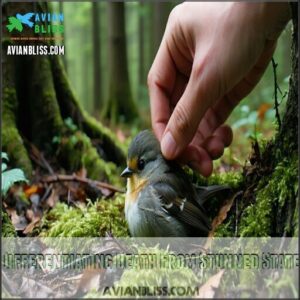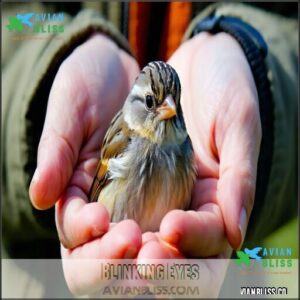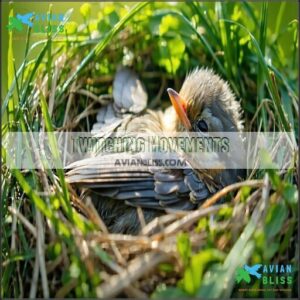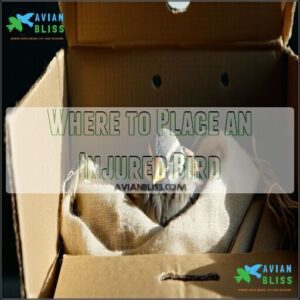This site is supported by our readers. We may earn a commission, at no cost to you, if you purchase through links.

Stunned birds often appear limp but will eventually move. Place the bird in a dark, quiet box with air holes and check every 30 minutes.
If there’s no movement after two hours, the bird has likely passed away. Remember, even motionless birds can recover—many window-strike victims are just "playing possum" while their nervous systems reset.
Knowing these subtle differences might just save a feathered friend’s life.
Table Of Contents
- Key Takeaways
- How to Tell if a Bird is Dead or Just Stunned?
- Differentiating Death From Stunned State
- Signs of a Stunned Bird
- Indicators of Potential Fatality
- Distinguishing Between Death and Sleep
- Assessing Bird for Injuries
- Where to Place an Injured Bird
- Frequently Asked Questions (FAQs)
- How can you tell if a bird is stunned or dead?
- What are the signs of a stunned bird?
- What happens if a bird is stunned?
- What should you observe in a stunned bird?
- How can you tell if a bird is still alive?
- What does a stunned bird look like?
- How long do birds stay stunned?
- Why is this bird not moving?
- Is My bird Dying or Sleeping?
- Is a bird dead if it hits a window?
- Conclusion
Key Takeaways
- Check for signs of life by looking for gentle chest movements indicating breathing, warmth to the touch, blinking or moving eyes, and foot reflexes when gently touched.
- Place a stunned bird in a dark, quiet box with air holes, away from pets and noise, and check on it every 30 minutes—many birds that appear dead are simply in shock.
- A stunned bird will typically have a limp, flexible body that feels warm, while a dead bird will develop rigor mortis, becoming stiff with fixed wing positions and cold to the touch.
- Most stunned birds recover within minutes to hours if given proper care—if there’s no movement after two hours, the bird has likely passed away, but be patient as recovery times vary by species.
How to Tell if a Bird is Dead or Just Stunned?
When you discover a motionless bird, determining whether it’s dead or just stunned can mean the difference between saying goodbye and saving a life. Start by observing from a distance – a stunned bird may appear completely still but show subtle signs of life.
Look closely for breathing observation – check if the chest gently rises and falls. Even faint movements indicate the bird is alive. For heartbeat detection, place two fingers gently on the bird’s chest, or listen carefully if you have a stethoscope.
Test for stimulus response by making a small noise or moving nearby. A living bird might twitch or blink in response. Examine the eye condition – clear, occasionally blinking eyes suggest life, while fixed, cloudy eyes often indicate death.
Check muscle tone by gently touching a wing or leg. A stunned bird will have some flexibility, while a dead bird will be completely rigid or floppy.
Trust your instincts – where there’s warmth, there’s often life.
Differentiating Death From Stunned State
When you find a bird not moving, you need to quickly figure out if it’s dead or just stunned. The difference could mean saving a life.
Check these essential signs to determine the bird’s condition:
- Breathing Patterns: Watch for slight chest movements. A stunned bird will have gentle rises and falls, while a dead bird shows no breathing.
- Heartbeat Detection: Place your fingertip gently on the bird’s chest or use a stethoscope if available. Even weak heartbeats indicate life.
- Stimulus Response: Lightly touch the bird’s feet. A stunned bird might twitch or flinch.
Body temperature tells you a lot – a warm bird is likely alive, while cold stiffness suggests death. Eye condition matters too; blinking or responsive eyes mean the bird is stunned, while fixed, glassy eyes typically indicate death.
Remember, birds can appear dead when they’re actually in shock. **Consider checking the bird’s eyes for reflexes.
Signs of a Stunned Bird
You’ll notice several key indicators when a bird is stunned rather than deceased, including subtle movements, open or blinking eyes, and a warm body with faint breathing.
While a stunned bird may appear lifeless at first glance, careful observation will reveal gentle chest movements, occasional twitching, or slight responses to gentle stimuli that signal life continues, showing subtle movements.
Here’s a short, engaging blockquote in the same tone as the paragraph:
Even in stillness, life whispers its presence through the faintest flutter of breath and subtle twitch of wings.
Limp Body
Now that you know the key differences between death and stunning, let’s look at what a limp body tells you about a bird’s condition.
When you find a bird not moving, its muscle tone gives important clues. A stunned bird feels floppy and relaxed when gently touched – like a sleeping child rather than a stiff toy. If the bird’s wings droop naturally and its body feels warm and pliable, there’s good news – it’s likely just stunned.
In contrast, a truly dead bird develops rigor mortis, making the body stiff and rigid. The legs won’t bend easily, and the wing position becomes fixed rather than flexible.
Here’s what to check:
- Muscle tone – stunned birds feel "floppy" while dead birds feel stiff
- Body temperature – warmth means life is still present
- Wing position – naturally drooping vs. rigidly fixed
- Leg stiffness – flexible legs suggest the bird is alive
Blinking Eyes
While a limp body provides initial clues, a bird’s eyes tell the true story of its condition.
When examining a potentially stunned bird, eye movement is your most reliable indicator. A living bird will show blinking frequency—even if irregular—and its eyelids will open or close in response to light or nearby movement.
Here’s a short, engaging blockquote in the same tone as the paragraph:
Look for the story in their eyes—even a subtle blink whispers that life remains when all else seems still.
You can test the bird’s reflex by gently moving your hand near its face (without touching). If the eyes follow your movement or blink in response, you’re looking at a stunned bird that’s still alive.
Pay attention to eye clarity too. Clear, bright eyes suggest life, while cloudy, dull, or glassy eyes often indicate a dead bird. The pupil response is equally important—living birds’ pupils will contract in bright light.
Remember: closed eyes don’t automatically mean death. Sometimes an injured bird keeps its eyes shut from exhaustion or swelling, but is very much alive.
Observation State Action Life Signs
Twitching Movements
Twitching movements point to life in an unresponsive bird.
You’ll notice subtle wing flutters, leg jerks, or tail movements that signal the bird is stunned, not dead.
Even minor beak trembles indicate the nervous system is still active.
- Recovery Sign: Twitching frequency and intensity often increase as the bird regains consciousness.
When you gently touch a stunned bird, these movements might become more pronounced.
The twitching duration typically lasts from minutes to hours, depending on the injury severity.
Don’t give up too quickly—even faint twitches mean there’s hope!
Indicators of Potential Fatality
Many birds that appear dead may actually be stunned.
When evaluating potential fatality, check these critical signs:
Breathing: No chest movement for several minutes suggests death.
Heartbeat: Use fingertips or stethoscope to detect even faint pulses.
| Indicator | Stunned Bird | Dead Bird |
|---|---|---|
| Body Temperature | Warm | Cold |
| Eye Appearance | Blinking | Fixed, Glassy |
| Body Rigidity | Limp | Stiff |
Foul Odor: An unpleasant smell often indicates a dead bird.
Cold Body: Birds lose warmth quickly after death.
Lack of Response: Unresponsive birds showing no reaction to gentle touch may have passed.
Always double-check for subtle signs of life before making conclusions.
Distinguishing Between Death and Sleep
The peaceful slumber of a bird can be easily confused with injury or death. When you’re trying to distinguish between sleep and more serious conditions, focus on the bird’s Sleep Posture—sleeping birds typically tuck their heads under wings or rest comfortably on perches.
Watch for Breathing Differences—sleeping birds have gentle, rhythmic chest movements, while dead birds show none. A stunned bird may have irregular breathing patterns.
Mourning doves, for example, often sleep in dense trees for safety.
- Eye Closure: Sleeping birds close eyes but may peek if disturbed; dead birds have fixed, unresponsive eyes
- Body Temperature: Sleeping birds remain warm; dead birds cool quickly
- Movement: Occasional shifting or twitching in sleep; complete stillness in death
- Response to Stimuli: Sleeping birds wake to gentle sounds; stunned or dead birds don’t
Assessing Bird for Injuries
When examining an injured bird, always start with a thorough but gentle assessment to avoid causing additional stress or harm.
Carefully inspect for visible injuries without applying pressure. Gently spread wings to check for hidden damage and lightly feel for abnormal swellings that might indicate fractures.
Signs of injury in a stunned bird include:
- Wound Assessment: Look for cuts, punctures, or broken skin
- Bleeding Control: Note any active bleeding that needs immediate attention
- Fracture Identification: Check for unusual angles in wings, legs, or neck
- Neurological Damage: Watch for head tilting or coordination problems
- Internal Injuries: Look for labored breathing or unusual posture.
Remember, a seemingly dead bird might just be stunned, so proper injury assessment helps determine if rehabilitation is possible. You may also need to take into account gentle handling techniques to minimize further trauma.
Where to Place an Injured Bird
You’ll need to place an injured bird in a quiet, dark box lined with soft cloth to reduce stress and promote healing.
The container should be well-ventilated with small air holes and kept in a warm, quiet area away from pets and children while you monitor the bird’s condition.
Safe Shelter Options
Now that you’ve assessed the bird’s injuries, you’ll need to create a proper sanctuary for its recovery. A safe shelter is vital for a stunned bird’s survival chances.
When choosing box materials, opt for a cardboard shoebox or small pet carrier with ventilation holes. Line it with a soft towel or paper towels to prevent further injury. If you don’t have a box, cage alternatives like a paper bag or laundry basket covered with a cloth can work in a pinch.
For the bird’s comfort and safety, remember these essentials:
- Temperature control: Keep the shelter warm but not hot (around 80-85°F)
- Predator protection: Place the box in a quiet room away from pets
- Minimal disturbance: Check on the bird only once every hour
- Proper ventilation: Make certain air holes are present without creating drafts
"Think of it as creating a bird’s hotel room," a wildlife rehabilitator once told me. "They need peace and quiet to check out in better shape than they checked in. A suitable option includes a specialized recovery enclosure for ideal care.
Proper Environment for Recovery
Creating a proper environment is vital for a stunned bird’s recovery. The right setup can mean the difference between life and death for your feathered patient.
Place the bird in a dark, quiet space away from household traffic, pets, and noise. Darkness calms the bird’s nervous system and reduces stress during this vulnerable time.
For ideal recovery conditions:
- Maintain temperature between 85-90°F to support the bird’s natural body heat regulation
- Use a ventilated container (cardboard box or paper bag) with soft towels as bedding
- Position the container away from drafts, direct sunlight, and heating/cooling vents
Keep handling to an absolute minimum. Every touch increases stress and can worsen shock. Consider using a specialized heating source to maintain optimal warmth. The safe space you create serves as a temporary emergency room, giving the stunned bird time to regain strength naturally.
Monitor from a distance, resisting the urge to constantly check progress. With proper setup and patience, many stunned birds bounce back surprisingly well.
Providing Necessary Care
After finding a stunned bird, place it in a ventilated cardboard box lined with soft cloths for warmth provision. Position this "bird recovery room" away from noise, pets, and high-traffic areas to reduce stress.
For hydration methods, set a shallow water dish nearby but don’t force-feed the bird—this could cause harm. Perform an injury assessment by gently checking for obvious wounds without handling unnecessarily.
Keep the room dimly lit and quiet. A bird recovery box can provide a safe and secure environment. Every 30 minutes, check for breathing by watching for subtle chest movements. A bird eye test can help determine consciousness—alert eyes indicate life, while fixed, glassy eyes may suggest bird death signs.
If the bird becomes active, prepare for safe release in a protected area. For serious injuries, contact a wildlife rehabilitation expert for consultation.
Remember: your temporary care can be the difference between recovery and a dead bird, so maintain proper warmth and minimal disturbance.
Frequently Asked Questions (FAQs)
How can you tell if a bird is stunned or dead?
You’ll know a bird is stunned, not dead, if you see chest movement, feel warmth, notice eye blinking, detect a heartbeat, or observe twitches.
Dead birds are cold, stiff, with fixed eyes, and lack the warmth that is present in stunned birds.
What are the signs of a stunned bird?
As still as a statue, a stunned bird shows signs of life through shallow breathing, body warmth, occasional eye blinking, muscle twitches, and minimal movement when stimulated.
They’ll often appear limp with relaxed wings.
What happens if a bird is stunned?
A stunned bird appears immobile but is still alive.
You’ll notice minimal breathing, closed or blinking eyes, and occasional twitching.
They’ll recover within minutes to hours if kept in a quiet, warm place.
What should you observe in a stunned bird?
Like a hibernating computer on standby, a stunned bird will show subtle signs of life.
You’ll notice faint breathing, occasional twitching, warmth in its body, and possible blinking or response to gentle stimuli.
How can you tell if a bird is still alive?
Check for chest movement indicating breathing. Look for eye blinking, body warmth, twitching, or responses to gentle stimuli. You’ll see feather fluffing or subtle head turning in a live bird.
What does a stunned bird look like?
A stunned bird appears motionless with fluffed-up feathers, open or blinking eyes, and may show shallow breathing.
You’ll notice occasional twitching, head tilting to one side, and it’ll feel warm when gently touched.
How long do birds stay stunned?
Your feathered friend isn’t taking a vacation!
Birds typically remain stunned for 10 minutes to 4 hours.
Recovery time varies by species, injury severity, age, and health.
Some bounce back quickly, others need more time.
Why is this bird not moving?
Your bird may be stunned from a collision, sick, cold, or actually deceased. Look for subtle breathing, twitching, warmth, or eye movement to determine if it’s alive but temporarily immobilized.
Is My bird Dying or Sleeping?
To distinguish between a sleeping and dying bird, check for steady breathing, warmth, and occasional movement.
Sleeping birds appear relaxed while dying ones may show labored breathing, coldness, and unresponsiveness to gentle stimuli, which can indicate a bird is dying rather than just sleeping.
Is a bird dead if it hits a window?
Like a boxer after a knockout, a bird that hits a window isn’t necessarily dead.
It’s often stunned and may recover within minutes to hours if you provide a quiet, safe space.
Conclusion
Will your next bird encounter leave you wondering how to tell if a bird is dead or just stunned?
Remember, patience is key. By checking for breathing, warmth, eye movement, and foot reflexes, you’ll make the right call.
Don’t rush to conclusions—many stunned birds recover with time in a quiet, dark space. Your quick, informed response could mean the difference between life and death for these delicate creatures.
Trust these signs, and you’ll know what to do.










